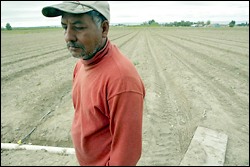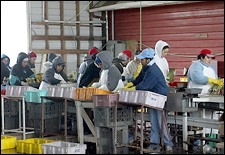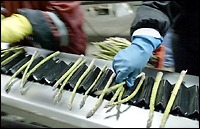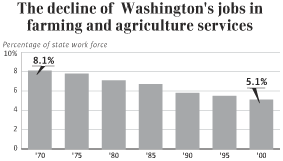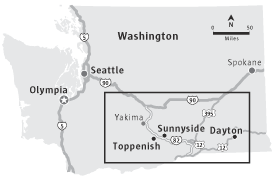 |
 |
 |
| Your account | Today's news index | Weather | Traffic | Movies | Restaurants | Today's events | ||||||||
|
|
Monday, June 28, 2004 - Page updated at 10:06 a.m.
Trade winds buffet state's farmers
Seattle Times business reporter SUNNYSIDE, Yakima County — Thirty years ago, Manuel Rivera took a leap of faith into the global economy. He was 15 when he left his home in Mexico and sneaked across the border to reach this rural hamlet of orchards, fields and feedlots. Drawn by low-wage jobs few Americans wanted, he picked apples and cut asparagus. He worked hard, raised a family and saved enough money to buy a small asparagus farm of his own. Now the global economy is taking back what it gave him.
Del Monte, which always had bought Rivera's crop for its canning factory in nearby Toppenish, didn't need it when the two-month harvest started in May. The company instead had contracted with a cannery in Peru, where asparagus is grown year-round, an acre yields three times as many spears and workers earn a tenth of what Rivera makes.
The factory closures are only catching up to what has already taken place on the farm. Since 1991, when a trade agreement opened U.S. markets to Peru's farm exports, more than half of Washington's asparagus fields have been plowed under. Many farmers say they will never grow the crop again, since it takes three years to establish a new field. Some are quitting farming entirely, leaving idle land to gather weeds. Manuel Rivera isn't sure what he'll do. Standing on the stoop of his doublewide mobile home, he looks at nine dusty acres, the fruit of 13 years of bank payments.
"They're going to ship their canned asparagus over here with a lower price," he says of the Peruvians. "What are we supposed to do with ours?"
Worldwide harvest makes way to U.S. store shelves On a drive through Eastern Washington, agriculture hardly looks like a dying industry. Big sheds, walls of wooden crates and brightly painted processing plants dot fertile valleys. Thousands of acres are painstakingly planted in tidy orchards, trellises and rows. Each spring, thousands of migrants arrive to help harvest $5.6 billion worth of crops. Agriculture still is a large slice of the state's $223 billion economy; food processing is the second-largest source of factory jobs after transportation equipment. But Rivera's troubles are rumbling across the fields. Falling trade barriers have opened U.S. grocery shelves to the bounty of the world. It's a bonanza for consumers, who enjoy better food year-round at lower prices. That has proved disastrous for many U.S. farmers. Overseas crops have displaced much of what they used to sell at home, and claimed foreign markets, too.
The simple asparagus spear reveals how global economics collide with the countryside, and how fluidly the fortunes from farm and factory jobs can shift — or disappear altogether.
If asparagus can't survive as a Washington-grown staple, can other crops be far behind? Grapes, raspberries, pears, apples, cherries, potatoes, the famous cut tulips of Skagit Valley — all are now imported from cheaper foreign suppliers.
In Hermiston, Ore., potato king J.R. Simplot will shut his French-fry factory this fall. The 625 workers used to supply McDonald's franchises as far away as Singapore. Now some of the work will be done outside the U.S., which is importing more fries than ever.
Dream came true, but now it's fading Three decades of effort may have bought Manuel Rivera a better life than he would have had in Mexico. But it hasn't bought luxury. His double-wide mobile home is sagging, and the doors are coming apart. The carpet is lumpy, and the television is small. Rivera, 46, never planned to stay in the U.S. He arrived in 1975 determined to make some money and return to his hometown, Colima, Mexico, in a year. "Every year, I thought, 'I'll save a little more and get more money to go back,' " he says. A practical, hardworking man, he still doesn't speak English. But he is an expert at picking apples, cherries and grapes and at pruning trees and vines.
Over time, he figured it was better to work here, even at low-wage field jobs, than return home to even less opportunity. He saved enough to buy land — something that would have been impossible in Mexico, he says.
But the American dream that brought Rivera here and took almost 30 years to build has, in two years, been knocked apart. Hard work and sacrifice — all that defined his life here — appear to be failing him. It cost $10,000 to sow his field and three years for the plants to mature. Now his land will produce for a decade. But when Green Giant leaves next year, there will be no guaranteed buyer for about half of the state's asparagus crop. Rivera's crop may not even be worth the cost of harvesting.
Hope dies hard Despite such risks, many farmers remain drawn to the land. George Smith, a burley 59-year-old who has been growing pears since the 1970s, is planting new trees and expanding his orchard to 20 acres, half of his farm in Zillah, which also grows cherries. Canned pears from China and South Africa sell for $4 a case less than Smith's, and there's nothing to keep the factories from moving overseas. But he has declined offers to sell. "I don't know what else I'd do," he says. "I've got nowhere else to go." Besides, he loves the life. "Ever get up on a spring morning and walk across a plowed field? There's an odor that comes from that soil. I can't describe it." Mike Bever studied agriculture in college and owned orchards. In the mid-1980s, he went broke during the Alar apple scare and now runs a commercial cleaning business. He sees how risky farming is, with foreign imports and abandoned acreage all around. Yet he can't help wishing. "I have this horrible desire to jump back in to it," he says. Others have seen no choice but to let go, however reluctantly. In Yakima, Toppenish Mayor Blaine Thorington leans against the yellow school bus he drives for a living, squinting in the afternoon sun. His family sold asparagus to Del Monte for three generations. After Del Monte's announcement, he plowed under his last 30 acres. "Sometimes I lay awake at night and think, I couldn't make it when my dad and granddad could," he says. "But it just kinda became clear to me that it was eating away at my retirement. I just didn't want to end up in 10 more years with nothing." On the Yakama Nation reservation, which covers much of the land between Toppenish and Mount Adams, a $20,000 irrigation pivot stands in a field of weeds. Over the past decade, large tracts of land like this, which farmers used to lease from the tribe, have fallen into disuse. "We have orchards that are more or less deserted," says Acey Oberly, superintendent of the Yakama Agency. "We just haven't been able to get people to come in and bid on the leases." What expansion there is in Washington's agriculture industry comes mostly from wineries, whose angle-roofed villas and sleek signs are worlds away from the barns and billboards touting apples and antiques. But with Chilean wine selling for $3 a bottle, Washington's grape farmers are under attack, too. "Watch the auctions," says Bever. "Farm after farm after farm is being auctioned off."
Fighting back This season, at least, Manuel Rivera has found a savior, a farmer who agreed to buy his asparagus crop. He wears a denim bomber jacket, scuffed brown cowboy boots and a confident smile.
Rich Rasmussen, 51, is a true asparagus believer. Raised on a Skagit Valley dairy farm, he moved east to Granger, Yakima County, and began growing produce on 3 acres in 1976. Now he and his brother, Greg, farm 300 acres of asparagus, part of a 1,200-acre spread.
It can rip through 80 tons a day, producing 160,000 one-pound bundles, with half the workers of his other packing lines, where workers sort spears by hand. And it allows him to bundle similar sizes more quickly and accurately, producing a consistent product that fetches a higher price. Rasmussen's line is just one of the things Washington is doing to save its industry. The Legislature this year allocated $3.8 million to help the asparagus industry buy sorters and other equipment. "If they can mechanize, they can create a few good-paying jobs and eliminate a lot of the minimum wage jobs," said state Sen. Jim Honeyford, R-Sunnyside, at the time. Lawmakers also eased rules that blocked unbundled asparagus from being shipped out of state, helping growers sell more easily. The federal government anted up, too, buying canned asparagus for food programs and to keep the Dayton, Columbia County, plant running. Many believe technology can save the industry. Better seeds and machinery saved many farms toward the end of the last century, often at the expense of jobs. The 300,000-square-foot plant that cans Green Giant asparagus, in Dayton, is said to be the most highly automated in the industry. At Del Monte's plant in Toppenish, a conveyer line connected with a can-making factory next door. Freshly minted cans shot onto production lines that churned out millions of cases in a few short weeks every spring.
"Let's kill broccoli!" But Peru is going high-tech, too. Jose "Pepe" Chlimper is sitting on a barstool at Torchy's restaurant in the Washington Athletic Club in Seattle. At 49, this dynamo is Peru's newest grower — and its largest exporter of fresh asparagus. His farm, Agrokasa, now raises more asparagus than Washington state's entire fresh crop last year. And he only planted his fields in 1999. His two cellphones chirp constantly, forcing Chlimper to put down his Mac & Jack's ale and walkie-talkie with the world. The Peru office tells him 60,000 pounds were harvested today. "Isn't that nice?" he says with a grin. Miami tells him it sold half of the crop at $1.25 a pound, a price that includes 50 cents for airfreight. A "spy" in Baltimore tells him California asparagus is selling for $3.99 a pound at Whole Foods, meaning U.S. companies that handled his crop could be making $2.74 a pound. More than half of the markup on asparagus comes on the U.S. side, not Peru, he says. But asparagus isn't why Chlimper is here. He has come to make a deal on grapes. Vanguard International, an agricultural broker in Issaquah, is selling Chlimper's grapes in China. Chlimper's embrace of the global economy is total: a Peruvian businessman, educated at North Carolina State University, using Nextel and AT&T Wireless phones to do business in Issaquah and China. He logs it all meticulously on a Compaq laptop, running Microsoft Windows. Chlimper has hosted Washington asparagus growers at his farm in Peru and visited theirs earlier this month. He says Washington growers, lulled by decades of selling to the canneries, tried to save the dying canned market rather than seeking alternative buyers. Peru's labor-cost advantage is largely offset by airfreight to the U.S., he says. So Washington could still be competitive selling fresh asparagus if growers aimed at the right market — fresh. "They were not seeing the big picture," he says — the decline in demand for canned asparagus, and the rise of the fresh market. Rather than keeping canneries, U.S. farmers should be working together to build high-speed packing lines, like Rasmussen's. "Let's kill broccoli!" he says. It has three times the market share and is ripe to be supplanted by his asparagus — and Washington's, if they care to join forces. But changing old ways is difficult. So far, he has no takers.
A field hand's story Peru's industry will continue to grow, driven by its natural advantages: year-round growing and a low-wage economy. Rivera and Rasmussen are competing with Carlos Ynca, a crew supervisor with CampoSol, one of Peru's largest growers. Ynca, 31, stands in a field as tree shadows reach slowly across the golden sand. Several pickers, baskets of asparagus tied behind their backs, step up. Ynca scoops their spears and places them in a plastic crate, which he loads on a truck. The fresh spears will be in the U.S. the next day. In 10 hours, his 12-member crew picks about 2,600 pounds of asparagus, earning $6 to $9 each, or about what field workers in Washington make per hour. He doesn't care much for the work. But like Rivera, he moved to take the job three years ago because it paid well. The home Ynca shares with his wife, Adriana, and two young daughters, makes Rivera's sagging, doublewide mobile home look like a palace. It's a 10-by-15 room with adobe walls and a single bare light bulb. The window is filled with bricks until Ynca can afford glass or patterned brick. The room holds two beds, two dressers, a chrome dinette and four chairs. Ynca saved six months to buy a 14-inch silver LG television; he keeps the remote in a plastic bag. Twice a week, his wife 28, walks five hours across the desert to collect firewood in the hills. She cooks in a reed hut built in her yard. Bricks on the ground hold her blackened pots and tea kettle. Cold water is available every other day for 90 minutes, from a hose in the yard. Ynca's pay is more than he could make in his home village. And, like Rivera, he knows living here offers hope to his children, who might otherwise be selling candy on the streets of Lima. "I started working here because they pay well," Ynca says. Kelly, his older daughter, is in kindergarten. Her uniform cost $6.50, a good day's wages. Shoes cost $10. The textbook $7.50. CampoSol lends money for these necessities. And it has built up her school, adding more classrooms and its first latrine. Before, children went in the schoolyard. "This life is better because we have what we need for the day, and we have what we need for food," Adriana says. But adjustment to the global economy is as hard for the Yncas as it is for the Riveras. Adriana misses the trees and greenery of her native mountains: "All I have here is a patch of sand." Back in Sunnyside, Manuel Rivera looks at his small field and wonders if there is a future in asparagus. He still thinks of his home in Mexico and dreams of retiring there. Meanwhile, "maybe I'll try corn," he says. Alwyn Scott: 206-464-3329 or ascott@seattletimes.com. Irene Keliher and Meylin Zink Yi served as Spanish interpreters in Peru.
|
|
|||||||||||||||||||||||||||||||||||||||||||||||||
seattletimes.com home
Home delivery
| Contact us
| Search archive
| Site map
| Low-graphic
NWclassifieds
| NWsource
| Advertising info
| The Seattle Times Company
